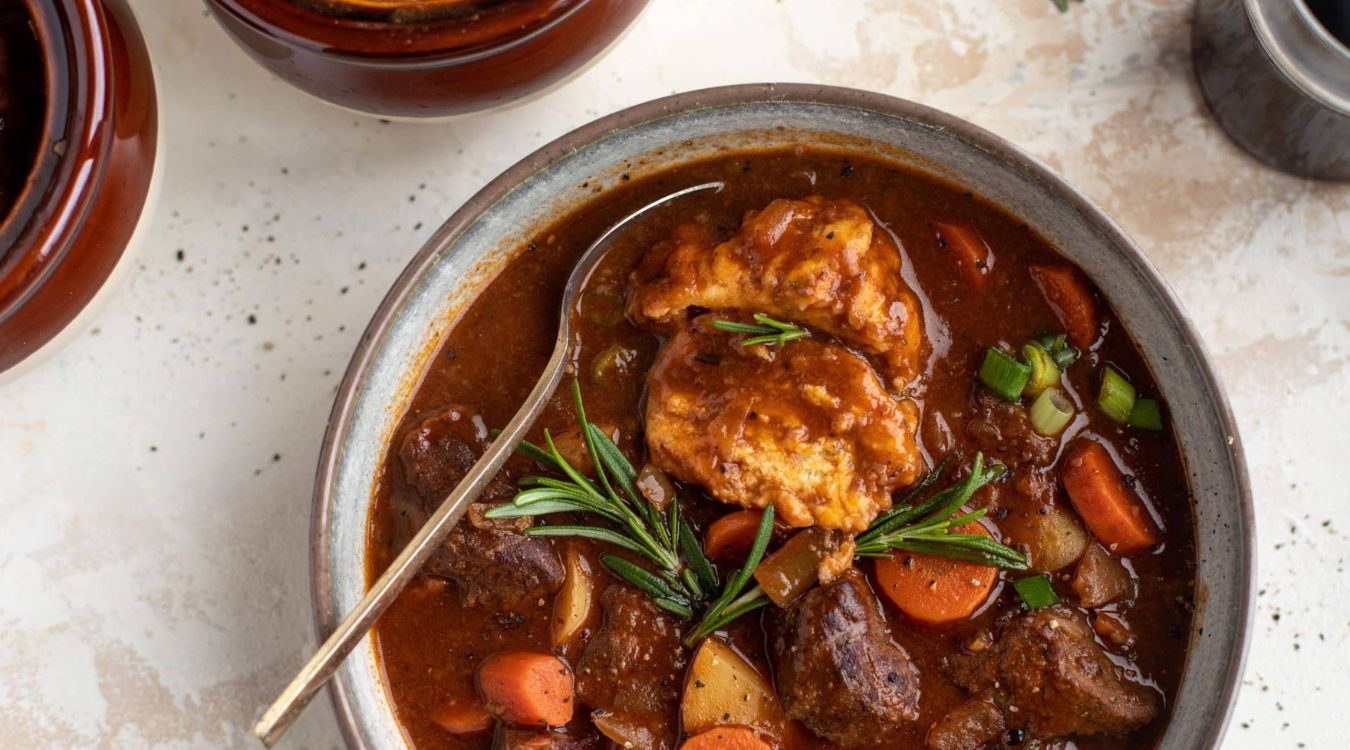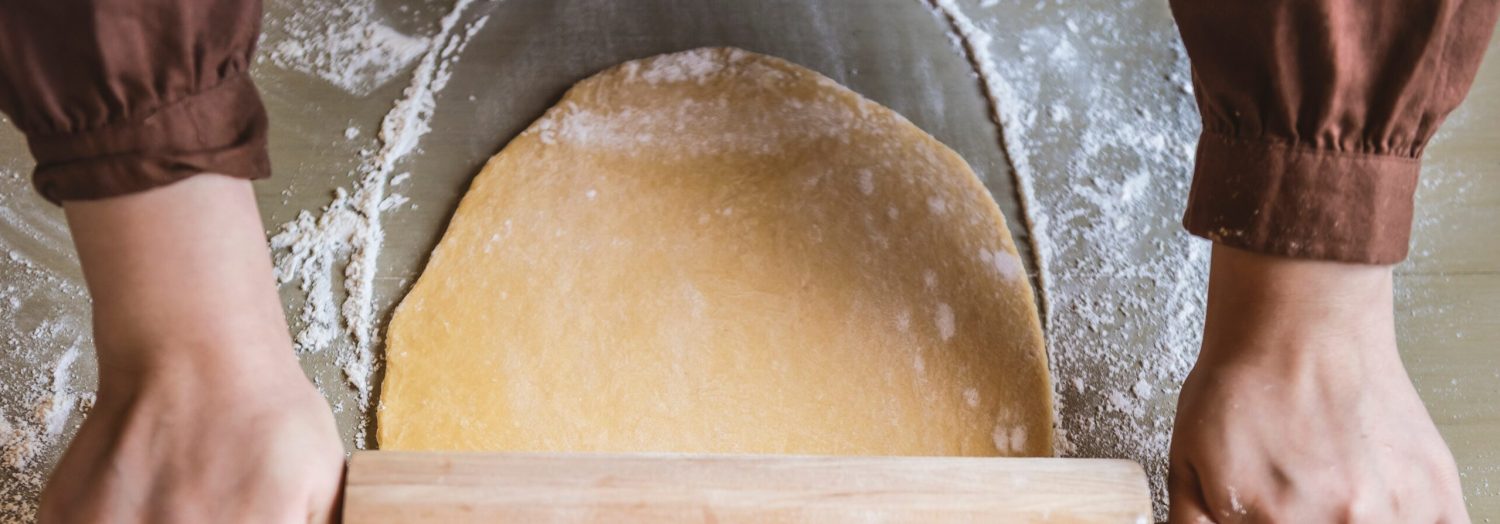Indulge in the comforting flavors of a classic beef stew with dumplings. This hearty dish combines tender chunks of beef with a medley of vegetables, all simmered in a rich, savory broth. Topped with fluffy dumplings, it's the perfect meal to warm you up on a chilly day.
When preparing this recipe, you may need to pick up a few items that aren't always in your pantry. Worcestershire sauce adds a unique depth of flavor, while dried thyme and dried rosemary bring aromatic herbal notes. Ensure you have tomato paste for richness and beef broth for the base of the stew.

Ingredients for Beef Stew with Dumplings
Beef stew meat: Chunks of beef that become tender and flavorful when simmered.
Olive oil: Used for browning the beef and sautéing the vegetables.
Onion: Adds sweetness and depth to the stew.
Carrots: Provide a subtle sweetness and texture.
Celery stalks: Adds a slight bitterness and crunch.
Beef broth: Forms the base of the stew, adding rich flavor.
Tomato paste: Adds a concentrated tomato flavor and richness.
Worcestershire sauce: Enhances the umami and depth of the stew.
Dried thyme: Adds an earthy, aromatic flavor.
Dried rosemary: Provides a pine-like, fragrant note.
Salt: Enhances all the flavors in the stew.
Black pepper: Adds a mild heat and depth.
All-purpose flour: Used to make the dumplings.
Baking powder: Helps the dumplings rise and become fluffy.
Milk: Adds moisture to the dumpling batter.
Melted butter: Adds richness to the dumplings.
Technique Tip for This Recipe
When browning the beef stew meat, make sure not to overcrowd the pot. Overcrowding can cause the meat to steam rather than brown, which will affect the depth of flavor in your stew. Brown the meat in batches if necessary to ensure each piece gets a nice, caramelized exterior.
Suggested Side Dishes
Alternative Ingredients
beef stew meat - Substitute with lamb stew meat: Lamb provides a similar texture and rich flavor, making it a great alternative for beef in stews.
olive oil - Substitute with canola oil: Canola oil has a neutral flavor and similar cooking properties, making it a suitable replacement for olive oil.
chopped onion - Substitute with shallots: Shallots offer a milder and slightly sweeter flavor, which can add a different but pleasant taste to the stew.
sliced carrots - Substitute with parsnips: Parsnips have a similar texture but a slightly sweeter and earthier flavor, which can add depth to the stew.
sliced celery stalks - Substitute with fennel: Fennel provides a similar crunch and a subtle anise flavor, adding a unique twist to the stew.
beef broth - Substitute with vegetable broth: Vegetable broth can be used for a lighter, vegetarian-friendly option while still adding flavor to the stew.
tomato paste - Substitute with crushed tomatoes: Crushed tomatoes can provide a similar tomato flavor and thickness, though you may need to adjust the quantity for consistency.
worcestershire sauce - Substitute with soy sauce: Soy sauce can provide a similar umami flavor, though it may be slightly saltier, so adjust the salt content accordingly.
dried thyme - Substitute with dried oregano: Dried oregano offers a different but complementary herbal flavor that works well in stews.
dried rosemary - Substitute with dried sage: Dried sage provides a warm, earthy flavor that can enhance the overall taste of the stew.
salt - Substitute with sea salt: Sea salt can be used in place of regular salt, offering a slightly different mineral content and flavor.
black pepper - Substitute with white pepper: White pepper has a milder flavor and can be used as a substitute, especially if you prefer a less pungent taste.
all-purpose flour - Substitute with whole wheat flour: Whole wheat flour can be used for a slightly denser texture and added nutritional value.
baking powder - Substitute with baking soda and cream of tartar: Combine ¼ teaspoon baking soda with ½ teaspoon cream of tartar to replace 1 teaspoon baking powder.
milk - Substitute with almond milk: Almond milk can be used for a dairy-free option, though it may slightly alter the flavor and texture of the dumplings.
melted butter - Substitute with melted coconut oil: Melted coconut oil can be used as a dairy-free alternative, providing a similar fat content and richness.
Alternative Recipes Similar to This Stew
How to Store or Freeze This Stew
Allow the beef stew to cool completely before storing. This helps prevent condensation, which can lead to a soggy texture.
Transfer the stew to an airtight container. For best results, use a container that is appropriately sized to minimize air space.
If you have leftover dumplings, store them separately from the stew. This prevents them from becoming overly soggy. Place them in a separate airtight container.
Label the containers with the date of preparation. This ensures you keep track of freshness and consume the stew within a safe timeframe.
For short-term storage, place the containers in the refrigerator. The beef stew will stay fresh for up to 3-4 days.
For long-term storage, freeze the stew. Ensure the containers are freezer-safe to prevent cracking. The beef stew can be frozen for up to 3 months.
When ready to reheat, thaw the stew in the refrigerator overnight if frozen. This gradual thawing helps maintain the texture and flavor.
Reheat the stew on the stovetop over medium heat, stirring occasionally to ensure even heating. If the stew appears too thick, add a splash of beef broth or water to reach the desired consistency.
If reheating dumplings, place them on top of the stew during the reheating process. Cover the pot and let them steam for a few minutes until heated through.
Enjoy your beef stew with dumplings as if it were freshly made, savoring the rich flavors and comforting textures.
How to Reheat Leftovers
For the stovetop method:
- Place the leftover beef stew with dumplings in a large pot.
- Add a splash of beef broth or water to maintain moisture.
- Heat over medium-low heat, stirring occasionally, until the stew is heated through and the dumplings are soft and warm.
For the oven method:
- Preheat your oven to 350°F (175°C).
- Transfer the beef stew with dumplings to an oven-safe dish.
- Cover the dish with aluminum foil to prevent the dumplings from drying out.
- Bake for about 25-30 minutes, or until the stew is bubbling and the dumplings are heated through.
For the microwave method:
- Place a portion of the beef stew with dumplings in a microwave-safe bowl.
- Cover the bowl with a microwave-safe lid or plastic wrap, leaving a small vent for steam to escape.
- Microwave on medium power for 2-3 minutes, then stir.
- Continue microwaving in 1-minute intervals, stirring in between, until the stew and dumplings are evenly heated.
For the slow cooker method:
- Transfer the leftover beef stew with dumplings to your slow cooker.
- Set the slow cooker to low heat.
- Heat for 2-3 hours, stirring occasionally, until the stew is hot and the dumplings are tender.
Best Tools for This Recipe
Large pot: A large pot is essential for browning the beef and simmering the stew. It provides enough space for all the ingredients to cook evenly.
Wooden spoon: A wooden spoon is ideal for stirring the stew and ensuring that the ingredients are well combined without scratching the pot.
Chef's knife: A chef's knife is necessary for chopping the onion, slicing the carrots, and cutting the celery stalks.
Cutting board: A cutting board provides a safe and stable surface for chopping and slicing the vegetables.
Measuring spoons: Measuring spoons are used to accurately measure the olive oil, tomato paste, Worcestershire sauce, thyme, rosemary, salt, and black pepper.
Measuring cups: Measuring cups are needed to measure the beef broth, flour, and milk.
Mixing bowl: A mixing bowl is used to combine the ingredients for the dumplings.
Whisk: A whisk helps to mix the flour, baking powder, and salt for the dumplings, ensuring they are well combined.
Tablespoon: A tablespoon is useful for measuring the melted butter and for dropping spoonfuls of dumpling batter onto the stew.
Lid: A lid is necessary to cover the pot while the dumplings cook, trapping steam and heat to ensure they cook through properly.
How to Save Time on Making This Stew
Pre-cut vegetables: Buy pre-cut onions, carrots, and celery to save chopping time.
Use a slow cooker: Combine all ingredients in a slow cooker and let it cook while you focus on other tasks.
Instant broth: Use store-bought beef broth to avoid making it from scratch.
Pre-mixed spices: Prepare a mix of thyme, rosemary, salt, and pepper in advance.
Quick dumplings: Use store-bought biscuit dough instead of making dumplings from scratch.

Beef Stew with Dumplings
Ingredients
Stew Ingredients
- 2 lbs Beef Stew Meat cut into chunks
- 2 tablespoon Olive Oil
- 1 Onion chopped
- 3 Carrots sliced
- 3 Celery Stalks sliced
- 3 cups Beef Broth
- 2 tablespoon Tomato Paste
- 2 teaspoon Worcestershire Sauce
- 2 teaspoon Dried Thyme
- 2 teaspoon Dried Rosemary
- 2 teaspoon Salt to taste
- 1 teaspoon Black Pepper to taste
Dumpling Ingredients
- 2 cups All-Purpose Flour
- 1 tablespoon Baking Powder
- 1 teaspoon Salt
- 1 cup Milk
- 2 tablespoon Butter melted
Instructions
- Heat olive oil in a large pot over medium heat. Add beef and cook until browned.
- Add onion, carrots, and celery. Cook until vegetables are softened.
- Stir in beef broth, tomato paste, Worcestershire sauce, thyme, rosemary, salt, and pepper. Bring to a boil, then reduce heat and simmer for 1.5 hours.
- For dumplings, mix flour, baking powder, and salt in a bowl. Stir in milk and melted butter until just combined.
- Drop spoonfuls of dumpling batter onto the simmering stew. Cover and cook for 15-20 minutes, until dumplings are cooked through.
Nutritional Value
Keywords
Suggested Appetizers and Desserts for This Recipe
More Amazing Recipes to Try 🙂
- Vegan Chow Mein Recipe30 Minutes
- Strawberry Daiquiri Recipe10 Minutes
- Vegan Banh Mi Recipe30 Minutes
- Vegan Quinoa Stuffed Peppers Recipe50 Minutes
- Classic Old-Fashioned Recipe5 Minutes
- Vegan Chili Lime Jackfruit Tacos Recipe35 Minutes
- Vegan Burritos Recipe35 Minutes
- Mai Tai Recipe5 Minutes

Leave a Reply